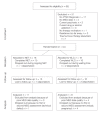Narrative exposure therapy for PTSD increases top-down processing of aversive stimuli--evidence from a randomized controlled treatment trial
- PMID: 22182346
- PMCID: PMC3258226
- DOI: 10.1186/1471-2202-12-127
Narrative exposure therapy for PTSD increases top-down processing of aversive stimuli--evidence from a randomized controlled treatment trial
Abstract
Background: Little is known about the neurobiological foundations of psychotherapy for Posttraumatic Stress Disorder (PTSD). Prior studies have shown that PTSD is associated with altered processing of threatening and aversive stimuli. It remains unclear whether this functional abnormality can be changed by psychotherapy. This is the first randomized controlled treatment trial that examines whether narrative exposure therapy (NET) causes changes in affective stimulus processing in patients with chronic PTSD.
Methods: 34 refugees with PTSD were randomly assigned to a NET group or to a waitlist control (WLC) group. At pre-test and at four-months follow-up, the diagnostics included the assessment of clinical variables and measurements of neuromagnetic oscillatory brain activity (steady-state visual evoked fields, ssVEF) resulting from exposure to aversive pictures compared to neutral pictures.
Results: PTSD as well as depressive symptom severity scores declined in the NET group, whereas symptoms persisted in the WLC group. Only in the NET group, parietal and occipital activity towards threatening pictures increased significantly after therapy.
Conclusions: Our results indicate that NET causes an increase of activity associated with cortical top-down regulation of attention towards aversive pictures. The increase of attention allocation to potential threat cues might allow treated patients to re-appraise the actual danger of the current situation and, thereby, reducing PTSD symptoms. REGISTRATION OF THE CLINICAL TRIAL: Number: NCT00563888Name: "Change of Neural Network Indicators Through Narrative Treatment of PTSD in Torture Victims" ULR: http://www.clinicaltrials.gov/ct2/show/NCT00563888.
Figures







References
-
- Mogg K, Bradley BP, Miles F, Dixon R. Time course of attentional bias for threat scenes: Testing the vigilance-avoidance hypothesis. Cognition and emotion. 2004;18(5):689–700. doi: 10.1080/02699930341000158. - DOI
Publication types
MeSH terms
Associated data
LinkOut - more resources
Full Text Sources
Medical
Research Materials

